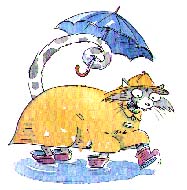|
________________
CM . . . .
Volume V Number 10 . . . . January 15, 1999
Using imaginative and often demanding vocabulary set in a simple rhyme scheme,
Dalton presents the essence of cats. She asserts that they can be kissy or
hissy, haughty or naughty, and can deflate or berate well-meaning owners. She
stretches the boundaries of her young audience's language by including in
context words such as uncouth, ornate, malice, staid, snide and many other
terms that help to define a cat's nature. At first reading, it is unlikely
that child or reader would want to interrupt the flow of the fast-paced rhyme,
but future readings, and these are guaranteed, will undoubtedly result in
extended discussion of the meanings of many of these words. The energetic
illustrations also help to explain unfamiliar words. For example, the vain cat
admires itself in a mirror, the tramp cat dresses as a hobo, and the
avant-garde cat sports sunglasses and a beanie.
There are references to cats encountered elsewhere, such as "grinning cats that
scared little Alice" accompanied by a Cheshire grimacing, and "brash succotash
cats that love to chase Tweeties." There is even a fez-wearing cat who is
reading the Rubicat illustrating "cats from Siam and cats that read poems by
Omar Khayyam." And, on the last page, "millions, gadzillions of cats," is
reminiscent of Wanda Gag's classic tale.
Dalton and LaFave joyfully affirm the essential uniqueness of cats for feline
aficionados and the uninitiated both. In Catalogue, a girl and her
kitten [like the little boy and his puppy in Doggerel] begin and end the
poem and provide a focus for the children listening. In both books, the final
page proclaims that, despite the variety of cats or dogs available, the most
important one is their own special pet.
Highly recommended.
Alison Mews is the Coordinator of the Centre for Instructional Services,
Faculty of Education, Memorial University of Newfoundland.
To comment on this title or this review, send mail to cm@umanitoba.ca.
Copyright © the Manitoba Library Association.
Reproduction for personal use is permitted only if this copyright notice
is maintained. Any other reproduction is prohibited without
permission.
Published by
TABLE OF CONTENTS FOR THIS ISSUE - JANUARY 15, 1999.
AUTHORS |
TITLES |
MEDIA REVIEWS |
PROFILES |
BACK ISSUES |
SEARCH |
CMARCHIVE |
HOME
|


 According to Webster, "catalogue" is derived from the Greek verb "to list,"
and, with this title pun to set the tone, Dalton proceeds to list, in
rollicking rhyme, the many idiosyncrasies of cats. Teamed up again with
illustrator Kim LaFave, Dalton follows-up her successful picture poem book,
According to Webster, "catalogue" is derived from the Greek verb "to list,"
and, with this title pun to set the tone, Dalton proceeds to list, in
rollicking rhyme, the many idiosyncrasies of cats. Teamed up again with
illustrator Kim LaFave, Dalton follows-up her successful picture poem book,